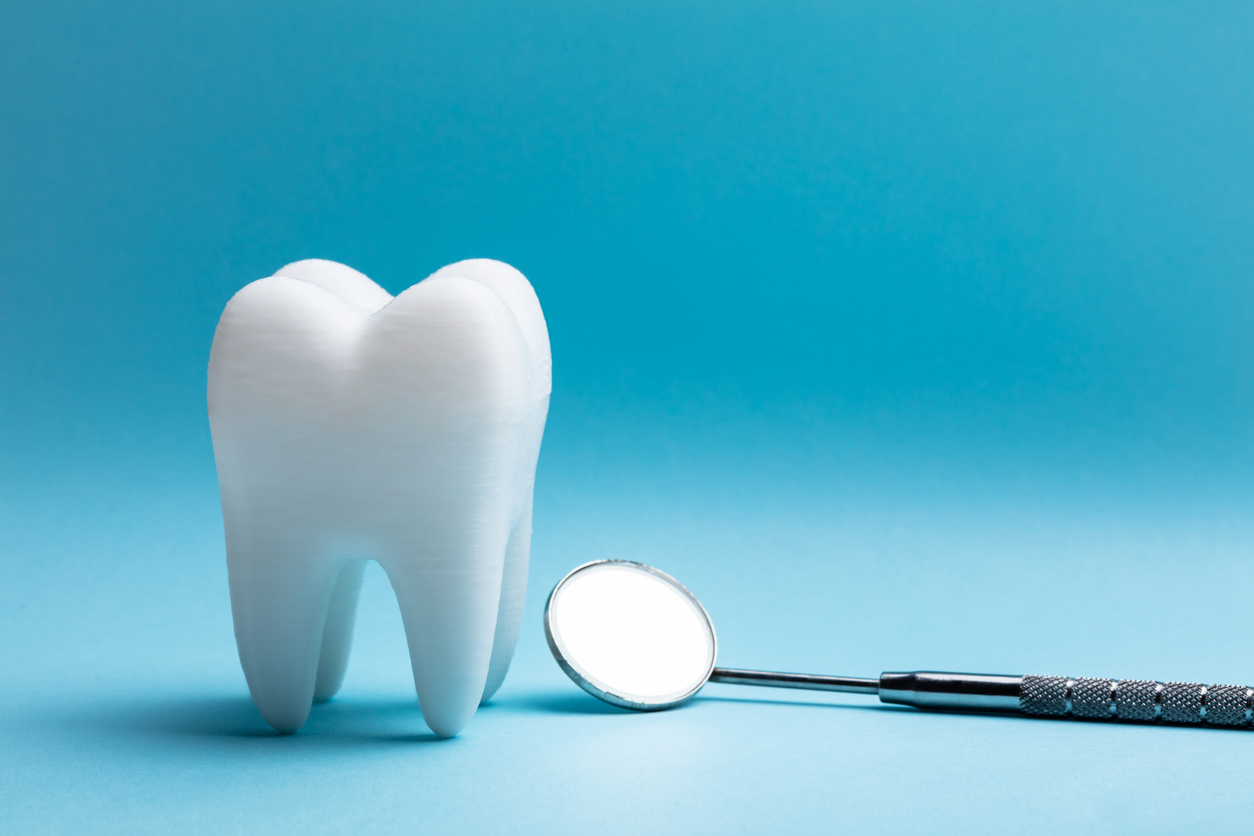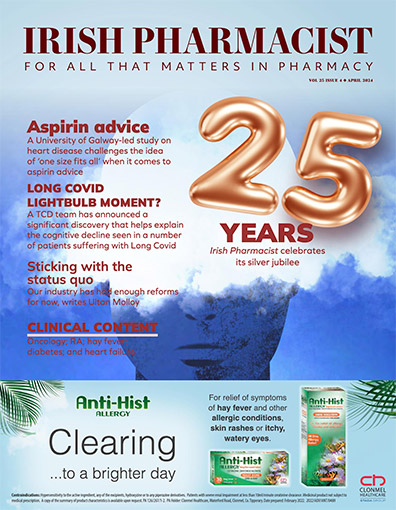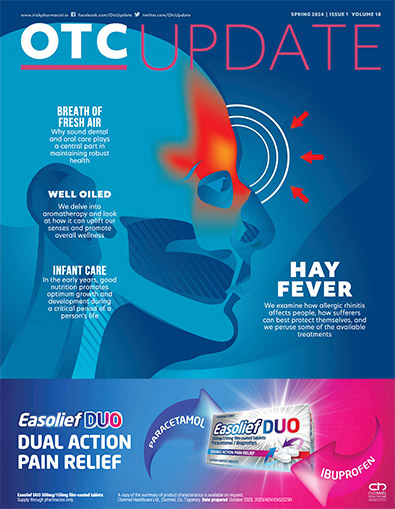Pharmacists are one of the most accessible parts of the health service and are in an ideal position to support dentists in helping patients to improve dental health
Dentists recommend that people have a cleaning and check-up every six months. Depending on a patient’s specific oral health needs, they may recommend a dental visit more often than that. However, many people visit their dentist far less frequently, for many reasons, including financial reasons, lack of time and fear of the dentist, among others. When patients visit a pharmacy with dental problems, the pharmacist is in an ideal position to encourage people to visit their dentist every six months, as prevention is better than cure. In this article, I discuss just a few of the more common dental problems pharmacists encounter in their practice.
Gingivitis (gum disease)
Gingivitis is more commonly called gum disease (also known as periodontal disease) and is caused by a build-up of bacteria in the gums. It causes gum irritation, red swollen gums, and bleeding. Gingivitis can be mild, and many people are not aware they have the condition and only get treatment when it is too late, ie, when gum and dental damage is evident. Gingivitis is generally not painful but if not treated early, it will result in more serious gum disease (periodontitis), which can cause tooth loss. Gum problems can begin in adolescent years and continue into adulthood.
Periodontitis and general poor oral health can have a detrimental effect on overall health. Periodontal disease is associated with more risk of heart attack, stroke and lung disease. In women, it is linked to premature birth or low birth-weight babies. It is not fully understood if periodontal disease is a cause of any of these conditions or why people with periodontal disease have higher incidences of these health problems.
Poor oral hygiene is the main cause of gingivitis, as it increases formation of plaque. Plaque is a ‘furry’ coating that forms on the tooth; it can be colourless or sometimes a pale-yellow colour. Plaque is a sticky film of bacteria that forms on teeth due to starches and sugars reacting with bacteria found in the mouth. Plaque requires removal daily (via brushing and flossing), as it re-forms quickly again within 24 hours after last
removal. If not removed, the bacteria in plaque forms acid which damages enamel and causes tooth decay and when it develops under the gums on the tooth’s root, it can lead to bone damage and eventual tooth-loosening and loss.
While poor oral hygiene is the most common cause of gingivitis, other factors that increase risk include smoking, being diabetic, increasing age, dry mouth, hormonal changes (due to pregnancy, menstrual cycle or taking the contraceptive pill), poor diet, substance misuse (ie, alcohol or illegal drugs) and poorly-fitting dentures.
Symptoms
Healthy gums will be firm and a pale pink colour. Signs of gingivitis include soft, puffy, tender, dark red and easy-bleeding gums (may be red or pink colour on the toothbrush or floss). Other signs include swollen gums, receding gums and bad breath. A dental appointment is important if some of these symptoms are noticed; a dentist can quickly diagnose gingivitis and advise on the just course of action. Prompt treatment will clear gingivitis symptoms and prevent development of more serious gum disease and tooth loss. Treatment requires professional care through the dentist followed by improved regular oral hygiene practice at home.
What a dentist will do
After checking teeth, the dentist (or dental hygienist) will thoroughly clean to remove all plaque and tartar. Dentists remove plaque and tartar using a procedure called scaling. Scaling may be temporarily uncomfortable, especially as gums are sensitive (which is often the case with gingivitis) or there is excessive plaque and tartar build-up.
The dentist may fix crowns or fillings (dental restorations) that make brushing and flossing in certain areas difficult. Teeth that are misaligned, crowns that are poorly fitting, bridges or fillings can irritate gums and prevent removal of plaque in certain areas by flossing and brushing, so the dentist may need to fix some of these issues. The dentist will advise on effective brushing and flossing techniques at home.
Self-help
Gingivitis will clear up with a thorough professional cleaning by a dentist or hygienist and if the person then practices good oral hygiene by brushing and flossing. There are steps a person can take to prevent and reverse gingivitis. These include regular professional dental cleanings (generally recommended as every six months). A soft toothbrush is best if there are gum problems and aim to replace it every three or four months to ensure maximum cleaning capacity.
Consider the use of an electric toothbrush, as it may be better for removal of plaque and tartar. It is important to brush teeth twice daily or better again, after every meal or snack. Floss at least once daily (this is where many people fail and it is very important). Use an antiseptic mouthwash if a dentist advises. A thorough cleaning using a toothbrush and floss will take three-to-five minutes if done properly.
Dry mouth
Dry mouth (medically known as xerostomia) is due to a reduction in saliva produced by salivary glands. Dry mouth is often a side-effect of medication and less frequently is caused by a condition that damages or blocks salivary glands. Dry mouth can vary from being a slight nuisance, to having a major effect on general health and dental health. It affects appetite and taste, hence reducing ability to enjoy food and reducing nutrition.
Dry mouth can vary from being a slight nuisance, to having a major effect on general and dental health
Saliva has many roles, including aiding digestion and enhancing our ability to taste food and allow easier swallowing. Saliva prevents tooth decay by neutralising acids caused by bacteria, preventing growth of bacteria and washing away food pieces.
Causes
Medicines
Many medicines, including many over-the-counter medicines, can cause dry mouth. Medicines with an anticholinergic effect are a common culprit. These include tricyclic antidepressants and older antipsychotic drugs, drugs used for neuropathy (ie, Gabapentin), benzodiazepines, some antihistamines (especially the ones that cause drowsiness), decongestants and analgesics, as well as muscle relaxants.
Ageing
The ageing process does not cause dry mouth, but older people have increased likelihood of conditions that cause dry mouth, as well as increased likelihood to be taking medicines that cause dry mouth.
Cancer treatment
Both chemotherapy and radiation therapy change the quality of saliva and can reduce the amount and quality of saliva produced. Radiation treatment of the head and neck area is especially known to damage salivary glands, thus reducing saliva. This may be reversible after treatment but in some cases, it may cause permanent damage and hence ongoing dry mouth.
Nerve damage
A head or neck injury or surgery that results in nerve damage to the head or neck can lead to dry mouth.
Other health conditions
Dry mouth can be a result of some health conditions, including Sjogren’s syndrome (an autoimmune disease which is a relation of arthritis and causes enlarged salivary glands, dry mouth, and dry eyes) and HIV/AIDS. Stroke and Alzheimer’s disease can make a person perceive they have dry mouth, despite normal functioning of the salivary glands. Snoring and breathing with an open mouth (while sleeping) can also contribute to dry mouth.
Smoking
Smoking can cause and exacerbate symptoms of dry mouth.
Symptoms
While dry mouth is a nuisance, it is the symptoms and problems caused by dry mouth that have the major impact on people’s lives. When not enough saliva is being produced, problems caused will include: Dryness of the mouth or throat; thick and stringy saliva; bad breath; changed taste sensations (or inability to taste flavours properly); problems with chewing; swallowing and speech problems; increased tooth decay and gum irritation and gum disease, and problems wearing dentures, including friction and pain.
Reduced saliva also leads to more oral problems, including increased plaque, tooth decay and gum disease, mouth sores, fungal infection (candida) in the mouth, coated (discoloured) tongue, cracked lips, and sores or skin splits occurring at the corners of the mouth. All these problems can lead to poor nutrition due to reduced ability to chew and swallow.
Treatment
Input can be from a doctor, dentist or pharmacist to advise on the condition. Initially an examination of the mouth, review of medical history and details of medicines being taken (including over-the-counter medicines) will be required to rule out and determine possible causes. Depending on the causes of dry mouth, a GP may need to change medicines that can cause dry mouth. In most cases there are alternative options that will not cause dry mouth. In some cases, it may not be possible to change the medicines causing the dry mouth, as there may not be suitable alternatives and the benefits may outweigh the risks.
Mouth-moisturising products
Options include mouth rinses, artificial saliva, or moisturisers that lubricate the mouth. For severe dry mouth, options include prescription medication that works by stimulating saliva. Options include pilocarpine or cevimeline that stimulates saliva production.
There are over-the-counter saliva substitutes available from pharmacies, including the Xerostom, Bioxtra and Biotene range of products. These brands come in the likes of gels, mouthwashes, toothpaste and chewing gums and have been shown in studies to increase saliva flow by up to 200 per cent and to relieve pain associated with dry mouth and improve taste and flavours. These products don’t just lubricate the mouth, but they also stimulate saliva flow.
Other tips
Sip water or sugar-free drinks regularly to moisten the mouth and drink water during meals, as it will help make chewing and swallowing easier. Use sugar-free chewing gum or suck sugar-free hard sweets. Bear in mind, however, that xylitol is often a sugar substitute in sugar-free products, and it can bring on diarrhoea and cramps if taken in large amounts.
Aim to breathe through the nose, not the mouth. Treatment for snoring may be recommended, as snoring causes breathing through the mouth during the night. A room humidifier may also help, as it will add moisture to the air while sleeping. Regular moisturisation of the lips will soothe dry or cracked areas. Because of increased risk of dental problems, regular check-ups with a dentist are recommended.
What to avoid?
Avoid substances that can exacerbate dry mouth, including caffeine and alcohol (these can cause dryness and irritation), avoid mouthwashes containing alcohol; avoid salty and dry food; stop smoking; and patients can discuss with their GP or pharmacist regarding medicines to avoid, including over-the-counter medicines that can cause dry mouth (such as antihistamines and decongestants).
Mouth ulcers
Also known as aphthous ulcers, mouth ulcers are painful, clearly defined, round or oval sores which form in the mouth. Most people suffer from occasional mouth ulcers, but one-in-five people suffer from recurrent mouth ulcers.
The three main types of mouth ulcer are:
Minor ulcer – This is the most common type of ulcer. It accounts for 80 per cent of all mouth ulcers. They are small (2-8mm in diameter) and normally heal naturally within 10-to-14 days. A minor ulcer will not cause any scarring.
Major ulcer — This type of ulcer is deeper and larger than a minor ulcer, and usually has a raised or irregular border. A major ulcer is usually 1cm or more in diameter. This type of ulcer will heal more slowly, over a period of several weeks, and can cause scarring. Approximately 10 per cent of mouth ulcers are major.
Herpetiform ulcers — These ulcers form as multiple, pinhead-sized sores. The number of ulcers can range from 5-to-100. These tiny ulcers often fuse together to form larger, irregular-shaped sores which are extremely painful. Approximately 5-to-10 per cent of mouth ulcers are herpetiform.
Mouth ulcers cannot be passed from person-to-person. For example, a person cannot get an ulcer from kissing someone, or from sharing a glass or cutlery.
Symptoms
A mouth ulcer will be round or oval. It will be white, yellow, or grey in colour, and will be inflamed around the edge. Most mouth ulcers will only last between 10-to-14 days, although in more severe cases, they may last for several weeks.
Depending on the causes of dry mouth, a GP may need to change medicines that can cause dry mouth
Causes
Most minor, single mouth ulcers are caused by damage to the mouth. For example, accidentally biting the inside of the cheek while eating or burning the inside of the mouth with hot food. Damage to the mouth can also occur if a toothbrush is used incorrectly, or from a sharp tooth, or filling.
Recurrent mouth ulcers
The cause of recurrent mouth ulcers is often unknown. However, some possible causes include:
- Oral trauma — ie, excessive tooth-brushing, or chewing sharp, or hard, foods.
- Anxiety.
- Stress.
- Certain foods — some people may find that eating certain foods can cause them to develop more ulcers. Foods that have been identified as increasing the risk of ulcers include chocolate, coffee, peanuts, almonds, strawberries, cheese, tomatoes and wheat flour.
- Hormonal changes — women notice that they are more likely to have an ulcer during their period due to hormonal changes.
- Stopping smoking — may cause a temporary increase in ulcers.
- Family history — ulcers can run in families.
- Underlying condition — certain conditions can cause ulcers, including vitamin B12 deficiency, iron deficiency, Coeliac disease, Crohn’s disease and immunodeficiency.
- Medication — some prescription medication can cause mouth ulcers. Examples include non-steroidal anti-inflammatory drugs, nicorandil and beta-blockers.
Treatment
Mouth ulcers will normally heal naturally without the need for treatment. However, if an ulcer lasts for more than three weeks, the patient should get checked by a GP as it may be due to a more serious condition. Some of the treatment options available over-the-counter or on prescription are as follows:
Corticosteroids
Should only be prescribed in more severe cases. A corticosteroid will reduce the inflammation of the ulcer, making it less painful. A GP may prescribe soluble prednisolone for the patient to use as a mouthwash in severe cases.
Antimicrobial mouthwash
Antimicrobial mouthwash helps to kill any micro-organisms, such as bacteria, viruses, or fungi that may cause a mouth infection if the patient cannot brush their teeth properly.
Analgesics
There are many over-the-counter remedies available in pharmacies.
When to refer?
Refer to a GP or dentist if a mouth ulcer lasts more than two-to-three weeks, particularly if it does not appear to be like my description in this article or shows no sign of healing or going away. This is because other types of ulcer can occur in the mouth and mouth cancer may first seem like a mouth ulcer.
Prevention
To prevent getting mouth ulcers, try to avoid becoming run-down by eating a balanced diet, take regular exercise, and learn to effectively manage stress. If prone to recurrent ulcers, try to avoid damaging the inside of the mouth by using a softer toothbrush and avoiding hard, brittle, or sharp-edged foods. Make sure teeth are in good order by regularly visiting a dentist. Flossing regularly reduces bacteria in the mouth.
Dental flossing
Proper dental flossing removes plaque and food particles from areas where a toothbrush cannot reach, including under the gum-line and between teeth. Plaque build-up can lead to tooth decay and gum disease. As brushing alone will not remove all plaque, daily flossing is highly recommended.
How to floss?
To ensure one gets to all areas that are inaccessible by toothbrush and to ensure the gums are not damaged by poor flossing technique, it is important to use the correct technique. Start with approximately 15 inches of floss. Wind most of the floss around each middle finger, allowing about two inches of floss to floss with. Grip the floss firmly between the thumbs and index fingers; glide it very gently up and down between the teeth.
It is important to curve the floss gently around the base of each tooth and ensure the floss goes beneath the gum-line to where more food can be trapped. Do not use a ‘sawing’ motion, as this will cut into the gums and damage the gums and cause bleeding. Likewise, do not snap or force the floss, as this will also damage the gums. It is best practice to use clean sections of floss when moving from tooth-to-tooth. To remove floss, use the same gentle back-and-forth movement to glide the floss out and away from each tooth base.
What type of floss to use?
To be very general, there is two main type of floss, a flat ‘tape-like’ floss, and round floss, which is thinner (basically like a thread). The ‘tape’ floss is designed to increase contact area with the tooth. There are other more ‘specific’ slight differences between different flosses, including differences in the material they are made from (nylon or polytetrafluoroethylene), whether they are waxed or unwaxed (waxed is meant to slide easier between teeth), different flavours, with or without fluoride, etc; however, these subtle differences do not make too much difference; the most important thing is to floss at least once daily and to use the correct technique to remove plaque and debris between teeth. It is up to individual preference which brand and type to use.
More about flossing
A thorough cleaning with a toothbrush and floss should take only three-to-five minutes. Flossing before brushing is important, as it clears food particles and bacteria between teeth that a toothbrush cannot reach. It is reckoned that 80 per cent of people do not floss. Brushing only reaches 65 per cent of the surface area of teeth; flossing is needed to reach the other 35 per cent. The patient should ask their dentist or hygienist how to floss properly.
What to expect if starting flossing for the first time
If a patient has never flossed before, they should see the gums turn a healthier pink colour within a few weeks of starting. If someone has never flossed before, gums may bleed slightly during the first few times, however this bleeding will stop after a few times. The reason for this initial bleeding is that inflamed gums are prone to bleeding due to gum swelling, meaning extra blood flow in the gums containing antibodies and nutrients aimed to protect from worsening gum disease. This inflammation reduces after the first few times flossing, so gums will stop bleeding after the first few times flossing.







